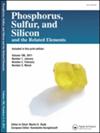Induction of resistance by enhancing silicified cells against shoot fly and stem borer pests of barnyard (Echinochloa frumentacea) and finger millet (Eleusine coracana)
IF 1.4
4区 化学
Q4 CHEMISTRY, INORGANIC & NUCLEAR
Phosphorus, Sulfur, and Silicon and the Related Elements
Pub Date : 2025-05-04
DOI:10.1080/10426507.2025.2492687
引用次数: 0
Abstract
Field experiments were conducted at Annapannai, Kudumiyanmalai and Agricultural College and Research Institute, Madurai in barnyard and finger millets to explore the efficacy of organic and inorganic sources of silica against borer pests. The per cent dead heart damage due to shoot fly in barnyard millet ranged from 4.16 to 7.67 among the treatments, the lowest was recorded in the treatment with basal application of 75% of 60 kg of calcium silicate/ha along with Trichogramma chilonis 5 cc/ha. But the incidence of dead heart due to stem borer was significantly less in the treatment with basal application of 75% of 60 kg of silica/ha along with neem formulation 2 mL/L and release of Trichogramma chilonis (5.53%) which was on par with 50% of 60 kg of silica/ha along with application of neem formulation 2 mL/L and release of T. chilonis (5.57%) and basal application of 60 kg of silica as calcium silicate alone (5.72%). Similarly, the white ear incidence ranged from 4.97 to 13.86% among treatments. The lowest incidence was recorded in the treatment with basal application of either 75% of 60 kg of silica as calcium silicate/ha along with need-based application of neem formulation 2 mL/L and release of T. chilonis. The number of silicified cells (7.11 Nos./sq.cm) and phenol content (4.16 mg/g) were significant in the treatment using 60 kg of silicon as calcium silicate which was on par with 75% of 60 kg of silicon as calcium silicate with neem formulation 2 mL/L. Regarding yield of barnyard millet, yield varied from 0.65 to 1.82 t/ha, the maximum in the treatment with basal application of 75% of 60 kg of silica/ha along with application of neem formulation 2 mL/L and release of Trichogramma chilonis (1.82 t/ha) with BC ratio of 2.20. In finger millet also, the same trend was observed. Observation on dead heart damage due to stem borer was recorded on 40 DAT. The per cent damage ranged from 4.14 to 10.23 among the treatments. The lowest incidence of dead heart was recorded in the treatment with basal application of 60 kg of calcium silicate/ha (4.14%) which was on par with basal application of 75% of 60 kg of silica/ha along with application of neem formulation 2 mL/L and release of Trichogramma chilonis (4.57%) and 50% of 60 kg of silica/ha along with application of neem formulation 2 mL/L and release of T. chilonis (4.61%). Similarly, the white ear incidence ranged from 5.21 to 17.20% among treatments. The lowest incidence was recorded in the treatment with basal application of either 75% of 60 kg of silica as calcium silicate/ha along with need-based application of neem formulation 2 mL/L and release of T. chilonis. The number of silicified cells (5.07 nos./sq.cm) and phenol content (3.20 mg/g) were significant in the treatment using 60 kg of silicon as calcium silicate. In finger millet, yield was maximum in the treatment with basal application of 75% of 60 kg of silica/ha along with application of neem formulation 2 mL/L and release of T. chilonis (2.56 t/ha) with BC ratio of 2.10.
增强硅化细胞对稗子和小谷子芽蝇和茎螟虫的抗性诱导
在Annapannai、Kudumiyanmalai和Madurai农业学院和研究所进行了田间试验,探讨了有机和无机二氧化硅源对螟虫害虫的防治效果。谷子蝇致死率在4.16% ~ 7.67%之间,以75% / hm2的硅酸钙用量(60 kg / hm2)和5 cc/ hm2的赤眼蜂处理最低。但是,在基础施用75%的二氧化硅/公顷,同时施用2ml /L的楝树配方,并释放赤眼蜂(5.53%)的处理中,由于茎螟虫而导致的死心发生率显著低于50%的处理,60 kg二氧化硅/公顷,同时施用2ml /L的楝树配方,释放赤眼蜂(5.57%),并单独施用60 kg二氧化硅作为硅酸钙(5.72%)。同样,不同处理的白耳发生率在4.97% ~ 13.86%之间。发病率最低的处理是基础施用75%的二氧化硅作为硅酸钙/公顷,同时根据需要施用2 mL/L的楝树制剂,并释放黄毛霉。用60kg硅酸钙处理的硅化细胞数(7.11个/平方厘米)和苯酚含量(4.16 mg/g)显著高于用2ml /L楝树配方的硅酸钙处理的75%。谷子产量变化范围为0.65 ~ 1.82 t/ hm2,以基础施用二氧化硅60 kg / hm2 75%,喷施印楝剂2 mL/L,释放赤眼蜂(1.82 t/ hm2), BC比为2.20的处理最高。在小米中也观察到同样的趋势。对40例茎蛀虫致死性心脏损伤进行了观察。不同处理的受害率为4.14% ~ 10.23%。在基础施用60公斤硅酸钙/公顷(4.14%)的处理中,心脏死亡的发生率最低,这与基础施用75%的60公斤二氧化硅/公顷并施用2ml /L的楝树配方并释放赤眼蜂(4.57%)和50%的60公斤二氧化硅/公顷并施用2ml /L的楝树配方并释放赤眼蜂(4.61%)相当。同样,不同处理的白耳发生率为5.21% ~ 17.20%。发病率最低的处理是基础施用75%的二氧化硅作为硅酸钙/公顷,同时根据需要施用2 mL/L的楝树制剂,并释放黄毛霉。在用60 kg硅作为硅酸钙处理时,硅化细胞数(5.07个/平方厘米)和酚含量(3.20 mg/g)显著增加。在小谷子中,基肥用量为75%,每公顷施用60公斤二氧化硅,同时施用2毫升/升的楝树制剂,释放2.56吨/公顷,BC比为2.10,产量最高。
本文章由计算机程序翻译,如有差异,请以英文原文为准。
求助全文
约1分钟内获得全文
求助全文
来源期刊
CiteScore
2.60
自引率
7.70%
发文量
103
审稿时长
2.1 months
期刊介绍:
Phosphorus, Sulfur, and Silicon and the Related Elements is a monthly publication intended to disseminate current trends and novel methods to those working in the broad and interdisciplinary field of heteroatom chemistry.

 求助内容:
求助内容: 应助结果提醒方式:
应助结果提醒方式:


